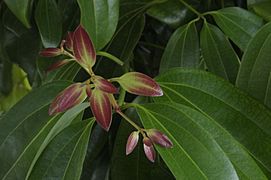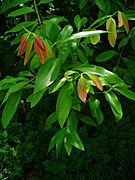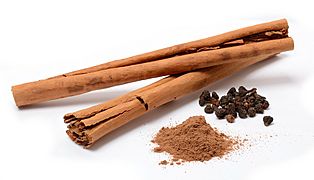Cinnamomum verum facts for kids
Quick facts for kids Cinnamomum verum |
|
|---|---|
 |
|
| Cinnamomum verum foliage and flowers | |
| Scientific classification | |
| Genus: |
Cinnamomum
|
| Species: |
verum
|
| Synonyms | |
|
|
The true cinnamon tree, also known as the Ceylon cinnamon tree, is a small evergreen tree. Its scientific name is Cinnamomum verum or Cinnamomum zeylanicum. It belongs to the Lauraceae family and originally comes from Sri Lanka. The spicy cinnamon we use comes from the inner bark of this tree. Sometimes, the word 'cinnamon' is used for other similar spices too, but this is the 'true' one!
Contents
What Does the Cinnamon Tree Look Like?
True cinnamon trees can grow quite tall, about 10 to 15 meters (30 to 50 feet). Their leaves are shaped like an oval, about 7 to 18 cm (3 to 7 inches) long. The tree's flowers are greenish and have a special smell. They grow in groups called panicles. The fruit is a small, purple, round berry about 1 cm (0.4 inches) wide, with one seed inside.
Where Does Cinnamon Grow?
The old name for the tree, Cinnamomum zeylanicum, comes from Sri Lanka's former name, Ceylon. Sri Lanka still produces most of the world's true cinnamon, about 80–90% of it! It is also grown in places like the Seychelles, Madagascar, and Tanzania.
You can also find Cinnamomum verum growing in Borneo, in areas like Sarawak, Sabah, and Kalimantan.
Different Kinds of Cinnamon Trees
There are several different types of true cinnamon trees. These types are known for having slightly different tastes in their bark. Some examples from Sri Lanka include Pani Kurundu and Naga Kurundu.
How Is Cinnamon Made?
Cinnamon trees are usually grown as leafy bushes, kept at about 3 meters (10 feet) tall. They are first harvested when they are 3 years old and can keep producing cinnamon for 40 to 50 years.
Here's how the spice is made:
- Small side branches, about 1.5 to 5 cm (0.6 to 2 inches) wide, are cut from the trees.
- The outer bark is taken off and used as mulch (a protective layer for soil).
- Twigs, leaves, and berries are crushed to make cinnamon oil, which is a less valuable product.
- The inner bark of the branches is carefully loosened using a brass rod.
- Then, the bark is split with a special knife and peeled off in long, whole pieces. Longer, unbroken pieces of cinnamon are worth more.
- These long pieces, called 'quills', are dried for several days, first in the shade and then in darkness.
- All this work is done by hand by skilled workers, which makes producing cinnamon spice quite expensive.
- Finally, the dried bark is cut into sticks or ground into powder for you to buy and use in your food!
Medicinal Uses of Cinnamon
Cinnamon has been used in traditional medicine for a very long time, especially to help with digestion.
Some early studies suggest that cinnamon might help slow down the symptoms of Alzheimer's disease. This is because it could help reduce certain protein clumps in the brain.
Gallery
See also
 In Spanish: Árbol de la canela para niños
In Spanish: Árbol de la canela para niños




